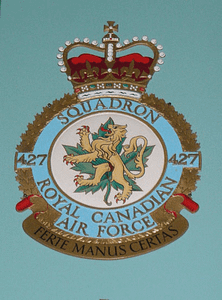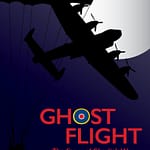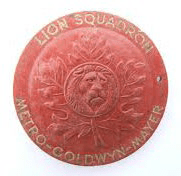

In April 1944, I went to my first RCAF squadron. I was in three different squadrons. The first one was the Lion Squadron, number 427, a Canadian squadron. Our barracks were in Skelfield manor house which had been turned into a private school and then taken over by the RAF during the war. It was a large estate at the back of the base. It was quite impressive quarters! The house had big fireplaces in each bedroom to heat the house. The gardens were landscaped with statues of lions and other animals. There was even a swimming pool on the grounds. With the 427 Lion Squadron, I did about three or four operations. I did the French operation around D-Day time.
I had a life pass to the movies because my first squadron was sponsored by Metro-Goldwyn Mayer. They gave us a life pass – a little red badge – a pass for the movies; anywhere that MGM had a movie. I don’t know if I ever got to use it in London; if they had any movies when I was on leave.

When I was in the Lion Squadron I met King George VI and Princess Elizabeth. The King was flying back from India and Princess Elizabeth, who was a lorry driver, came from London to greet her father. When the King stepped off the aircraft they had a big red carpet running out. I was a squadron marker; I had to stand there before everyone lined up, eh? I was at ease of course when they were putting the carpet down and then the King came down the steps of the airplane. The wind was blowing and the Princess was off to the right of the aircraft and saw him come down. He got to the carpet and started to walk and I guess the wind blew the carpet against his legs and the carpet rolled up. Out of the corner of my eye, I was looking at the Princess with a big grin on her face to see her father walking along the carpet which was blowing up behind him.
We then went into the intelligence room of the base to show them what was going on. The King and the Princess interviewed me and my friend Pete Wilsher (a friend from Dorval). I remember the Princess said to me, something like – you’re rather tall to be a gunner. I told her I was in the minority, but there were a few other tall gunners.
All Canadian squadrons were based in Yorkshire. I was transferred later from the Lion Squadron. My original crew from that squadron were all killed.
I had been called back to a training unit in Topcliffe, England over a misunderstanding about the checking out of a harness that I used while I had been there. After our training in Topcliffe, one of the other crew offered to bring the harness back inside for me, then we were going by truck back to our squadron. The guard at the gate told me the harness hadn’t been checked in yet. So I told him what happened; it must’ve been put back in the wrong locker. I gave him a quid, so he could find the harness and let me get on the truck. I didn’t want to be stuck there! Later on, I was called back to Topcliffe because I was being court marshalled because of a bribery charge over the same incident with the harness! A woman who worked in the base office had seen the whole thing and said it was a bribe. In the end, at the court marshal, she couldn’t identify me, so the charges were dropped.
So I got separated from my crew. While I was gone there was a man who replaced me as a rear gunner. When I got back to the squadron he didn’t want to leave. He said – no, I’m happy with this squadron, with this group. I didn’t put up an argument. My best friend said – sorry you’re not coming back!
Didn’t they go out for a trip and they were all killed! One of the crew was Johnny Williamson, the one I talked about earlier when we had to find our way back to base from the Midlands. He was mid-upper gunner, he and I were part of only a few who were really tall to be gunners. Johnny’s name is in the newspaper clipping “Quebecers Graduate as Wags”, even though he was from New Brunswick.
Charlie waited a long time before he told me about the close encounter with being court marshalled. With a bit of internet research, I found out that a lot of Canadians were brought to court marshal or came very close to being court marshalled. These were young men who in times of peace would not have joined the armed forces. Young men can get up to pranks, like the story of two brothers who stole a chicken. Food supply in Great Britain was very serious because no food was able to be shipped by sea. Luckily for the brothers, their Company Commander stuck up for them by reminding the British that Canadians were doing a lot to help in the war. Sending them home would not help the war effort at all. There are other stories about Canadians not being in proper uniform, according to RAF officers – one Canadian wasn’t wearing his gloves! Another Canadian told his tale of washing his uniform; while waiting for it to dry he went to a nearby pub in his civilian clothes. An officer saw him out of uniform and complained. The RAF officers were often career military and seemed to have a hard time coping with what they considered to be lax, colonial Canadians.
My friend George was on his fifth operation when he crashed; I didn’t know till 1945 that George had survived. Some airmen had their accidents on their first operation. Others didn’t reach that point – some fellows I knew from the west end of Montreal; they were killed at Topcliffe on the training unit I was on.

We crashed there but some survived. We were on Wellington bombers at that time. We lost Frank Grey, I think and Dawson. The Dawson family of Montreal, they were a printing company. Ricky Dawson went to school with me and he was killed in training at Topcliffe.
For a few weeks or so my duty was to escort those who went to be court marshalled. At one point – I remember the Commander – he said – well, you can fly or not fly. I said, listen I’m over here as a gunner, to fly! I don’t care who I fly with, you know, I’ll fly as a spare with anybody. I’ll get my operations in – my thirty trips in. You know some were fussy about – you get one pilot and crew, it’s like a team; like a hockey team. If I joined Canadians and a year later they traded me to Detroit or Boston, okay!

Then I went to 419, the Moose Squadron. That was at the base in Middleton, St. George. I was replacing a chap there who had bailed out; they were damaged. When the skipper says prepare to bail out, you just get ready, but this fellow misunderstood and jumped. He jumped from his tail turret into France, but he was okay. So I came along and that’s why I replaced him. He found his way back to the squadron, we were still operating but they didn’t use him anymore, because I had taken his place. I saw him around the squadron; I was sitting with our group and he came along and started kidding. I don’t think he got in trouble for bailing out; he may have behind the scenes, but none of us heard any more about it. He wasn’t even in official uniform; he put something gold on his hat – what the hell! It didn’t look like it was legal. You had to be very careful about the uniform.

The rest of the crew in the Moose Squadron finished their tour because they were already advanced, so I was transferred to the Ghost Squadron. Ghost Squadron was No. 428 Squadron. That was my last squadron, my last trip, twenty-nine and a half trips! On February 2, 1945, we went down over Wiesbaden, Germany.

We were taught, through intelligence training to be aware of a number of things; for instance not to carry money. I carried it – but I was very careful when I was shot down. I buried my life pass to MGM theatre. I took my money and I thought this is tough ‘cause I’m pretty tight with a buck. I had to throw all these pound notes in a little package. I threw it deep in the snow away from where I was. I wrapped it up in some little paper I had in my pocket. I knew that when I was captured they would take everything out of my pockets. They checked, so I had nothing to identify, except that I was RCAF, I had a Canada badge, and I gave name, rank and number.
I was ninety-nine days a prisoner. So, it was a little over three months, from the time they captured me.
Naming the Canadian Squadrons during the Second World War was not a unique idea. It had been done before for Commonwealth nations who were under the control of the British Royal Air Force.
In 1943, the Canadian No. 6 Bomber Group was formed. By 1945, we had forty-eight RCAF squadrons, sponsored and supported by Canadian groups or communities.
When Charlie was old enough to join, he went overseas when the RCAF had established itself. After just mentioning that Canadian squadrons were sponsored by Canadians, Charlie’s first squadron, the Lion, was the exception. RCAF’s public relations headquarters appealed to Metro-Goldwyn Mayer to sponsor the 427 Squadron. The benefits would be for the Canadians to be entertained by Hollywood stars, which up till then only entertained the American troops. Each RCAF aircraft was adopted by a movie star. The mascot was a bronze lion statue and each and every member was given a lifetime movie pass.

According to records of MGM’s sponsorship, the movie pass was a “small bronze medallion on a leather thong”. The Lion Squadron was honoured to have MGM sponsor them; even if it was a publicity coup for the movie company. During the war, the movie theatres, CBC Radio and the Wings Abroad publication provided information to the Canadian public about what was happening so far away. It must’ve pleased Canadians to have such sponsorship and helped to grab the imagination in a better way than all the doom and gloom news.
Charlie was transferred from the Lion to the Moose squadron. All of the named squadrons had their own special reasons for the name. The Moose Squadron was the only one named after their leader. Wing Commander John Fulton of Kamloops, British Columbia, nicknamed, ‘the Moose’ was an RAF veteran. He had joined the RAF in 1935. In his mid-twenties, he was appointed the commander of the new 419 Canadian squadron.
There are leaders who lead by discipline and feel they stand above the rest. Happily, there are also leaders like John, ‘the Moose’, Fulton. By all accounts, he was popular and intelligent, and everyone would gladly do anything he wanted. Unofficially the squadron named themselves the Moose Squadron and the members were ‘moose men’. The Mayor of London, senior members of the RCAF and other B.C. units honoured WC Moose Fulton and his squadron. Kamloops, B.C. adopted them; which meant that they were the sponsors for the Moose Squadron.
Unfortunately, Wing Commander Fulton and crew went missing shortly after the party in their honour. On an operation to Hamburg, in foul weather, Fulton’s plane was attacked by a night fighter. A search party went out the next day but there was no sign of the airplane. It was a sad day for the Moose Squadron.
Charlie’s third and last squadron was No. 428, the Ghost Squadron. When other squadrons were taking on identities, this group at first called themselves, ‘The Nameless’ Squadron. There’s no explanation why they felt they were nameless by they finally decided to call themselves the ‘Ghost Squadron’. The reason for the name was simple – night bombing was what Canadians were well known for; the squadron appeared like a ghost in the air and then disappeared back to base.
The 408 Squadron, ‘Goose’ was the first to submit a request for a heraldic squadron badge to the Chester Herald; the official office for military heraldry. The request and design then had to be approved by the King. Oddly enough, this was one protocol that the Canadians didn’t mind going through. Being part of a large, British run war machine was made more individual and Canadian. The RCAF overseas became known as the ‘flying menagerie’.